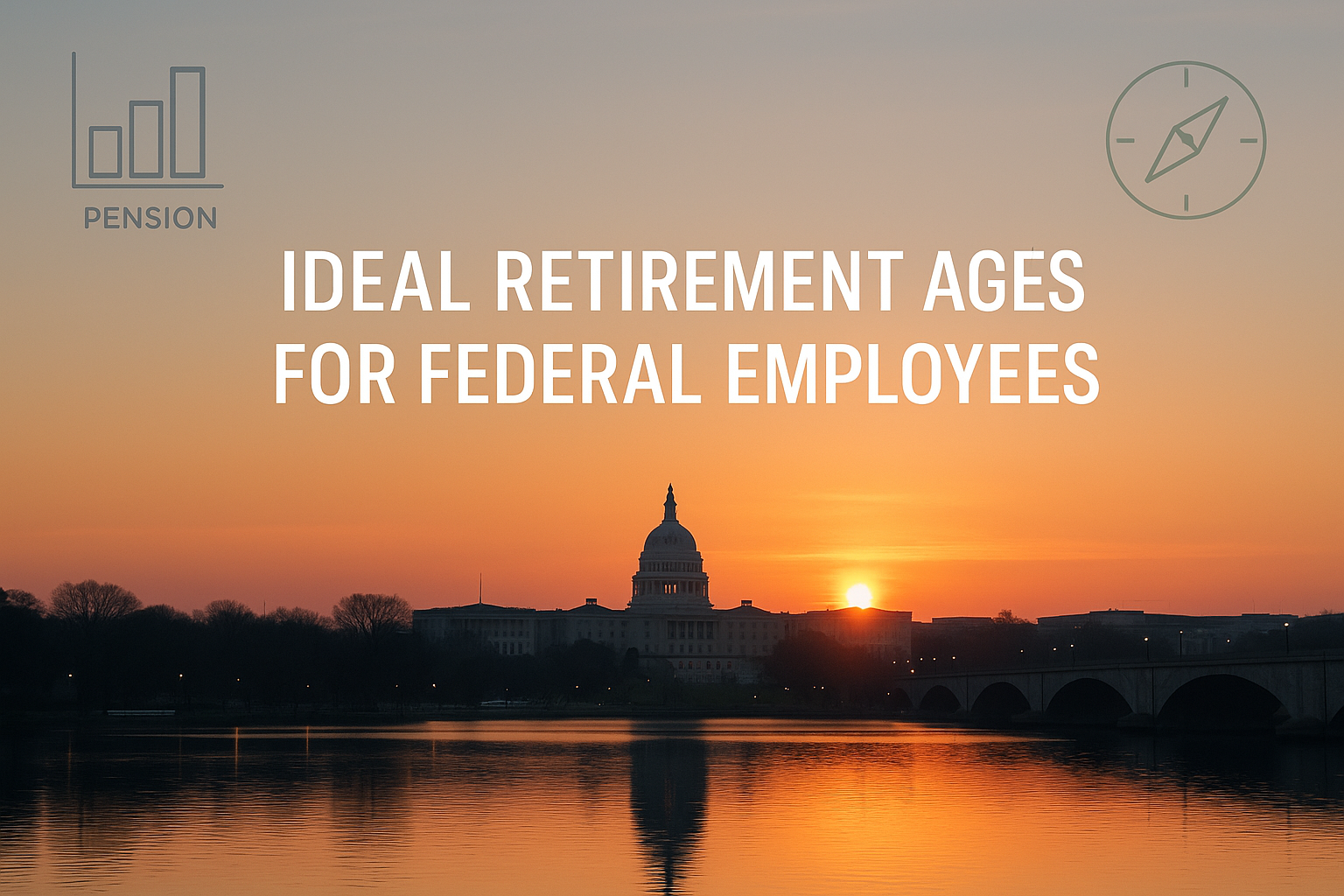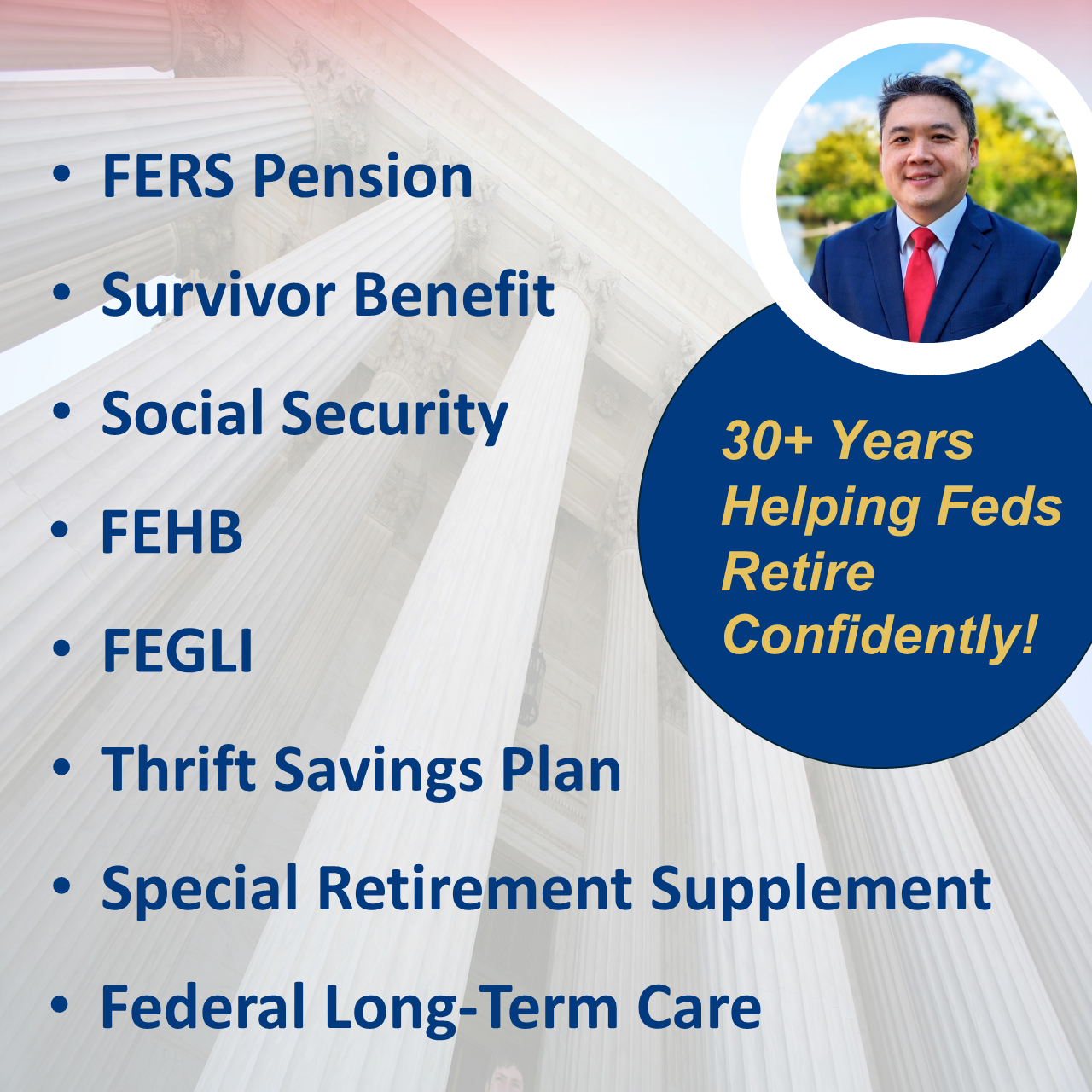Ideal Retirement Ages for Federal Employees: Maximize Your Benefits
For federal employees, the question of when to retire is more than just a date on the calendar. Each year—or even month—you continue working can shift your FERS pension, your Social Security strategy, your Thrift Savings Plan (TSP) balances, and ultimately your financial security. The difference between retiring at your Minimum Retirement Age (MRA), age 60, or age 62 can translate into lasting effects on your monthly income, cost-of-living adjustments (COLAs), and total lifetime benefits. Understanding how these moving parts interact may help you plan a retirement timeline that could mitigate penalties, enhance your annuity, and help you make the most out of Social Security.
At PlanWell Financial Planning—your dedicated financial advisor for federal employees—we’ve guided federal and military employees for over 30 combined years. Our team members hold the ChFEBC® (Chartered Federal Employee Benefits Consultant), CFP® (CERTIFIED FINANCIAL PLANNER™), and AIF® (Accredited Investment Fiduciary) designations, ensuring that our planning advice is both credible and specialized. We developed the Fed-Expert Financial Blueprint precisely because timing is so critical. It is a specialized process designed to help you see how all the pieces fit together so you can step confidently into retirement. In this post, we’ll look at the core ages, rules, and concepts you need to know to choose the retirement age that best fits your goals.
Why “When” Matters: The Financial Leverage of Your Retirement Age
It’s easy to think a year or two of service doesn’t make a significant difference in lifetime benefits. But consider how your pension is calculated under the Federal Employees Retirement System (FERS). One factor is your “high-3” average salary, multiplied by a percentage based on your years of service and age. If you qualify for an enhanced multiplier at 62, that seemingly small shift in age can produce thousands of extra dollars across the decades you might spend in retirement. Meanwhile, delaying retirement might also give you more time to contribute to your TSP, growing that nest egg. But every extra year of work has an opportunity cost: that’s one less year spent enjoying a new chapter of life, and you might also be deferring Social Security claiming strategies.
Ultimately, the goal is to determine if working longer can “move the needle” sufficiently to justify the additional time on the job. Because federal retirement income often involves both a pension and the FERS Supplement (if you retire before 62), the interplay between these benefits can be complex. In some situations, leaving earlier—particularly if you have 30 years by your MRA—makes sense because you’ll get uninterrupted benefits with no reduction. In others, you might favor waiting until 62 for the higher multiplier. Each path carries certain trade-offs, so let’s map them out in more detail.
Understanding FERS Eligibility Milestones
Not all federal employees face the same age thresholds. You might be aware of the “magical” numbers—MRA, 60, and 62—but the actual rules are nuanced. Here’s how to make sense of them.
Minimum Retirement Age (MRA) Table – Know Your Starting Line
Your MRA is the earliest point at which you can retire if you also have enough years of service. MRA depends on the year you were born, ranging from 55 (for employees born before 1948) to 57 (for those born in 1970 or later). If you need a refresher on how MRA fits into the overall ruleset, see our comprehensive MRA guide for FERS employees. The table below helps you quickly identify your Minimum Retirement Age.
| Year of Birth | Minimum Retirement Age (MRA) |
|---|---|
| Before 1948 | 55 |
| 1948 | 55 and 2 months |
| 1949 | 55 and 4 months |
| 1950 | 55 and 6 months |
| 1951 | 55 and 8 months |
| 1952 | 55 and 10 months |
| 1953–1964 | 56 |
| 1965 | 56 and 2 months |
| 1966 | 56 and 4 months |
| 1967 | 56 and 6 months |
| 1968 | 56 and 8 months |
| 1969 | 56 and 10 months |
| 1970 or later | 57 |
If, for example, you were born in 1966, your MRA is 56 and 4 months. Let’s say you’re approaching 30 years of service, but you’re still a few months shy. You might wonder if you can “round up” with sick leave. Unfortunately, unused sick leave can enhance your total service time for the pension calculation but cannot be used to hit the basic threshold for retirement eligibility. You must meet the required years of service in actual, creditable service first, and only then does sick leave add on for calculating the pension amount.
Full Immediate Retirement Rules (MRA+30, 60/20, 62/5)
Under FERS, the “full immediate retirement” combination means your pension is not subject to any reductions. If you meet one of these age/service milestones, you can walk away with an unreduced annuity:
• MRA (usually 56–57) with at least 30 years of service• Age 60 with at least 20 years of service• Age 62 with at least 5 years of service
These thresholds are fairly straightforward, but they matter tremendously. Retiring at 64 doesn’t inherently reward you with extra pension unless you have at least 20 years by 62—although you may see higher Social Security benefits if you delay beyond 62.
Early Retirement & MRA + 10: The 5 Percent Penalty Explained
Another pathway is the MRA + 10 option, where you can retire at your MRA with at least 10 years of service but fewer than 30. This creates an immediate annuity with a catch: for every year shy of age 62, you face a 5% permanent reduction. If you decide to leave at 57 (and you’ve met the 10-year threshold), you’ll reduce your retirement benefit by 5% multiplied by the five years between 57 and 62, or 25% total. That’s a meaningful drawback.
You do have one partial workaround—postponing the actual start of annuity benefits. If you hold off on collecting your pension until, say, 60 or 62, you decrease or eliminate the penalty. For a deeper dive on the difference between delayed and postponed retirements, see our guide to deferred vs. postponed retirement. Balancing that waiting period against a smaller monthly amount is where careful planning (and sometimes a deeper analysis through something like our Fed-Expert Financial Blueprint) can pay off.
Special Provision & Mandatory Retirement Ages
While most federal employees don’t have a mandatory retirement age, certain special provisions do apply to law enforcement officers, firefighters, air traffic controllers, and a handful of other positions. These workers often face a mandatory age of 57 (sometimes 56 for air traffic controllers). The trade-off is an enhanced pension multiplier—typically 1.7% of the high-3 average salary for the first 20 years, plus the standard 1.0% thereafter. Because of that higher multiplier, many in these special categories can accumulate a solid pension quicker but also must leave earlier, whether they feel ready or not. For a closer look at these rules, visit our complete guide to federal law-enforcement retirement. Here’s a quick look:
| Position | Mandatory Age | Special Multiplier | Notes |
|---|---|---|---|
| Law Enforcement Officer | 57 | 1.7% for first 20 yrs | Requires mandatory separation |
| Firefighter | 57 | 1.7% for first 20 yrs | Mandatory separation applies |
| Air Traffic Controller | 56 | 1.7% for first 20 yrs | Strict FAA rules |
| Certain Pilots | 56–65 | Varies | Agency-specific guidelines |
The Pension Multiplier Advantage at Age 62
There’s a somewhat hidden benefit for those who can stay until 62 with at least 20 years of service: the standard 1% multiplier jumps to 1.1%. That extra 0.1% might sound minor, but across a $100,000 high-3 salary, it translates to an extra $100 per year of service, every year, for life. Over 25 or 30 years in retirement, that difference can add up to tens of thousands in extra annuity income. Below is a simplified illustration comparing three scenarios:
| Scenario | Age | Years of Service | Multiplier | High-3 | Annual Pension | 10-Year Total |
|---|---|---|---|---|---|---|
| 60/20 | 60 | 20 | 1.0% | $100,000 | $20,000 | $200,000 |
| 62/20 | 62 | 20 | 1.1% | $100,000 | $22,000 | $220,000 |
| 62/22 | 62 | 22 | 1.1% | $100,000 | $24,200 | $242,000 |
The difference doesn’t end once you’ve calculated your first retirement year; it compounds as you receive annual cost-of-living adjustments on a larger base amount. Of course, not everyone wants to grind out those last few years if they’re burned out or if life circumstances shift. That’s where a personalized analysis can clarify whether it’s worth pushing to 62 for the multiplier or if you’re better off moving on earlier.
Coordinating FERS with TSP & Social Security
FERS was designed as a three-part system: your pension, Social Security, and your TSP. So as you map out your timeline, think about all three. Retiring at 57 or 60 triggers different strategies than if you wait until 62 or beyond.
Social Security Timing Versus FERS Annuity Supplement
If you retire with an immediate, unreduced FERS pension before age 62, you could be eligible for the FERS Annuity Supplement. This supplement is designed to replicate the Social Security benefit you otherwise could have received at age 62, but it stops the moment you turn 62—regardless of whether you actually claim Social Security then. Waiting on Social Security can yield about an 8% increase in benefits per year up to age 70, so many federal retirees consider bridging the gap with their TSP and the FERS Supplement until a later, more advantageous Social Security claim date.
In other words, at age 62, your FERS Supplement disappears, forcing you to rely on your own resources or start taking Social Security. Some retirees choose to claim Social Security right away to replace that lost supplement. Others tap their TSP for a couple of years while letting Social Security grow. The key is exploring how each option affects your lifetime benefits. If you’re not sure how these puzzle pieces fit, we invite you to join one of our free Federal Retirement Planning Workshops. You can see in real time how adjusting one factor ripples across the rest.
TSP Withdrawal Considerations and RMD Age 73
Federal employees have two major points to remember with TSP withdrawals: the penalty cutoff at 59½ (and certain other FERS-specific exceptions) and the required minimum distributions (RMDs), which now generally begin at age 73. If you’re retiring in your late 50s, you can often access TSP funds without the usual 10% penalty if you separate from service after the year you turn 55. Otherwise, you can begin “age-based” in-service withdrawals at 59½. Once you get to age 73, you’ll need to take at least the RMD amount each year to stay compliant with IRS rules.
It’s also wise to keep an eye on the TSP as a potential bridge between the end of the FERS Supplement (which stops when you turn 62) and the time you choose to initiate Social Security. This can help you postpone Social Security, potentially locking in a higher monthly benefit for life.
Putting It Together: Choosing Your Ideal Exit Age
Bringing all these factors together can feel like putting together a puzzle. On one hand, you have your pension with its unique age-and-service thresholds. You also have the FERS Supplement—if you leave before 62 on an immediate retirement—and the question of when to claim Social Security. Then add in TSP withdrawal rules and mandatory retirement ages for some occupations, and it’s clear why many federal employees find themselves with more questions than answers.
That’s exactly why we built the Fed-Expert Financial Blueprint, a step-by-step planning framework that captures each benefit, identifies your personal numbers (high-3 salary, years of service, TSP balance, Social Security estimates), and then evaluates how different retirement ages align with your lifestyle goals. Does it make sense to leave right at your MRA with 30 years, or should you wait to hit age 60 or 62? The trade-offs can be elegantly illustrated in one of our group sessions. Reserve your seat for our next FERS webinar, and we’ll walk you through typical federal scenarios and how these equations change if you adjust even a single component.
Case Studies
Case 1: 57-year-old HR Specialist – MRA + 30
Imagine an HR Specialist named Denise who just turned 57—her MRA. She’s accumulated exactly 30 years of credible service and is eligible for an immediate, unreduced annuity. She decides to retire right away to spend more time with family. Her high-3 is $90,000, giving her a FERS pension of $27,000 annually (1% x $90,000 x 30). She also receives the FERS Supplement to bridge her income until 62. Denise weighs using TSP withdrawals at around 59½ to give her extra flexibility and might defer Social Security until her full retirement age or later for a bigger benefit. This approach suits her lifestyle priorities while still preserving her ongoing finances.
Case 2: 60-year-old Law Enforcement Officer – Mandatory at 57, Defers Until 60
Now consider Ken, a federal law enforcement professional who had to retire mandatorily at 57 but had not yet reached 20 years of law enforcement service. Because he was short of the required threshold for an immediate special category pension, taking his pension right away would have resulted in an early retirement reduction. However, thanks to substantial savings, Ken decided to delay the start of his pension until age 60 so he wouldn’t face those penalties. Even though he technically separated from service at 57 under the special provisions, he arranged his finances to bridge his living expenses for those three years. By the time he initiated his pension at 60, he met the age 60/20 years threshold for a full, unreduced FERS annuity (counting other creditable federal service), and he timed his Social Security to begin right after his FERS Supplement expired at 62. This strategy minimized penalties, maximized his monthly annuity, and synced perfectly with his TSP drawdown plan.
Common Pitfalls & How to Avoid Them
A few recurring mistakes trip up many federal retirees. One is forgetting that sick leave won’t help you qualify earlier for retirement; it only adds onto your final pension once you’re already eligible. Another is missing the five-year coverage rule for continuing FEHB (health insurance) into retirement—if you haven’t been enrolled for at least five consecutive years leading up to your retirement date (or since your earliest opportunity), you can’t carry FEHB into retirement. Some also underestimate the cost of the survivor benefit option or misunderstand how service credit deposits for temporary or military service might alter their timeline. If you’re uncertain about the details, getting professional checks on your SF-50s, service computation date, and deposit history can prevent last-minute surprises. Our article on the Insurable Interest Survivor Annuity is a helpful primer.
Next Steps: Map Your Personal Timeline
Before finalizing any retirement date, it’s crucial to confirm your service history, verify your sick leave balance, and run a pre-retirement estimate using official calculators or consult a professional. Go through your SF-50s, gather your TSP statements, check your Social Security earnings record, and ensure all military buybacks or prior service adjustments are complete. Because these decisions can feel overwhelming, many feds in their late 50s or early 60s join our workshops for a comprehensive walk-through of strategies. Reserve your seat for our next FERS webinar and see how professionals with ChFEBC, CFP, and AIF expertise approach these timelines.
FAQ
Q: What is the minimum retirement age for federal employees?
A: Your MRA generally falls between 55 and 57, depending on your birth year. Refer to the table above for exact figures.
Q: Does retiring at 62 really increase my pension?
A: Yes. If you have at least 20 years of service, the multiplier jumps from 1% to 1.1%, boosting every future payment you receive.
Q: Is there a mandatory retirement age for most FERS workers?
A: In most federal positions, there is no mandatory retirement age. Special categories like law enforcement officers, firefighters, and air traffic controllers, however, must typically retire by age 57 (or 56 for air traffic control).
Q: How much is the early retirement penalty under MRA + 10?
A: For each year under age 62, you face about a 5% permanent reduction. If you retire five years early, that can mean a 25% reduction in your annuity.
Q: Can I keep FEHB health insurance if I retire early?
A: Yes, provided you’ve been enrolled for the five consecutive years before retirement (or since you were first eligible). Keeping your FEHB intact is a huge advantage of federal service, so don’t let that enrollment period slip off your radar.
If you’re considering your retirement age, remember that decisions about your pension, TSP, and Social Security are interconnected. By taking a holistic look at your timelines—and by leveraging expert tools like the Fed-Expert Financial Blueprint—you can select a retirement date with confidence that you’re making informed decisions about your benefits. When you feel ready for a deeper, more customized conversation, schedule a consultation with a PlanWell financial planner for federal employees or sign up for one of our free Federal Retirement Planning Workshops to gain clarity, run personal scenarios, and ensure your transition into retirement is as smooth and rewarding as possible.












